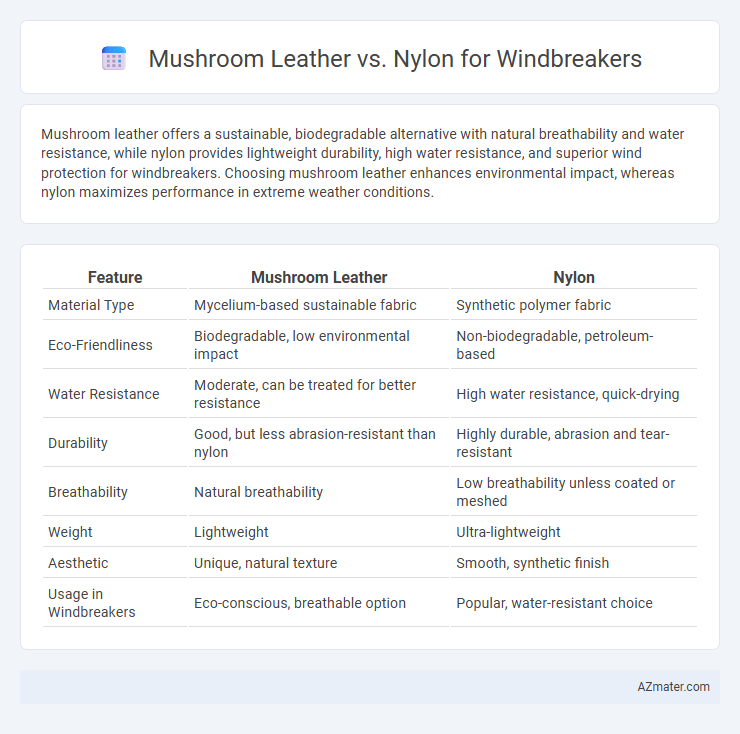Mushroom leather offers a sustainable, biodegradable alternative with natural breathability and water resistance, while nylon provides lightweight durability, high water resistance, and superior wind protection for windbreakers. Choosing mushroom leather enhances environmental impact, whereas nylon maximizes performance in extreme weather conditions.
Table of Comparison
| Feature | Mushroom Leather | Nylon |
|---|---|---|
| Material Type | Mycelium-based sustainable fabric | Synthetic polymer fabric |
| Eco-Friendliness | Biodegradable, low environmental impact | Non-biodegradable, petroleum-based |
| Water Resistance | Moderate, can be treated for better resistance | High water resistance, quick-drying |
| Durability | Good, but less abrasion-resistant than nylon | Highly durable, abrasion and tear-resistant |
| Breathability | Natural breathability | Low breathability unless coated or meshed |
| Weight | Lightweight | Ultra-lightweight |
| Aesthetic | Unique, natural texture | Smooth, synthetic finish |
| Usage in Windbreakers | Eco-conscious, breathable option | Popular, water-resistant choice |
Introduction: Mushroom Leather vs Nylon for Windbreakers
Mushroom leather, a sustainable and biodegradable material derived from mycelium, offers a lightweight, water-resistant, and eco-friendly alternative to traditional nylon used in windbreakers. Nylon, known for its durability, abrasion resistance, and quick-drying properties, remains a popular choice for performance outerwear but often relies on fossil fuels and emits higher environmental impact. Comparing mushroom leather to nylon highlights a shift towards innovative, plant-based materials that combine functionality with reduced ecological footprint in windbreaker production.
Material Origins: How Mushroom Leather and Nylon Are Made
Mushroom leather is derived from sustainable fungal mycelium, cultivated through a controlled fermentation process that transforms mushroom roots into a biodegradable, eco-friendly material. Nylon is a synthetic polymer produced from petrochemicals through a complex chemical reaction involving caprolactam, resulting in a durable, lightweight fabric commonly used in windbreakers. The production of mushroom leather emphasizes renewable biological resources, while nylon relies heavily on fossil fuel extraction and chemical manufacturing.
Durability and Performance Comparison
Mushroom leather offers excellent durability with natural water resistance and breathability, making it a sustainable alternative for windbreakers that resist wear and tear over time. Nylon excels in high tensile strength and abrasion resistance, providing lightweight wind and water protection ideal for active outdoor use. Compared to nylon, mushroom leather delivers superior biodegradability and comfort but may require more maintenance to retain performance in extreme weather conditions.
Environmental Impact: Sustainability and Biodegradability
Mushroom leather, derived from mycelium, offers a sustainable alternative to conventional materials due to its renewable growth process and low environmental footprint, significantly reducing carbon emissions compared to nylon production. Nylon, a synthetic polymer derived from petrochemicals, is associated with high energy consumption and greenhouse gas emissions during manufacture, and its non-biodegradable nature contributes to long-term environmental pollution. Mushroom leather biodegrades naturally within months, minimizing landfill accumulation, whereas nylon can persist in the environment for centuries, posing challenges to waste management and ecosystem health.
Comfort and Breathability Factors
Mushroom leather offers superior breathability and natural moisture-wicking properties, enhancing comfort during extended wear compared to synthetic fabrics. Nylon windbreakers, while lightweight and water-resistant, often lack the same level of breathability, which can lead to increased perspiration and reduced comfort. The biodegradable composition of mushroom leather also contributes to a softer, more flexible texture that adapts better to body movements, promoting overall comfort.
Weather Resistance: Water and Wind Protection
Mushroom leather offers excellent water resistance due to its natural hydrophobic properties, making it highly effective at repelling moisture and keeping the wearer dry during wet conditions. Nylon is lightweight and provides strong wind protection through its tightly woven fibers, but it often requires additional coatings to achieve comparable water resistance. When evaluating windbreaker materials, mushroom leather excels in durability and water repellency, while nylon prioritizes wind protection and breathability.
Style, Texture, and Aesthetics
Mushroom leather offers a unique, eco-friendly alternative to traditional materials with a soft, supple texture that mimics natural leather, enhancing the windbreaker's style with an organic, matte finish. Nylon provides a sleek, lightweight texture with a slightly glossy appearance, giving the windbreaker a sporty and modern aesthetic. The choice between mushroom leather and nylon significantly impacts the garment's visual appeal and tactile experience, balancing sustainability against performance-driven style.
Cost Analysis: Price and Accessibility
Mushroom leather windbreakers typically cost 20% to 40% more than nylon alternatives due to higher production expenses and limited scaling in sustainable materials. Nylon windbreakers offer wider availability and lower prices, often ranging between $30 to $70, while mushroom leather options commonly start around $80 and can exceed $150. Accessibility remains a major factor as nylon dominates global supply chains, whereas mushroom leather is still emerging, limiting consumer options.
Maintenance and Care Requirements
Mushroom leather windbreakers require gentle cleaning with a damp cloth and should be kept away from excessive moisture to prevent degradation, highlighting their need for delicate maintenance. Nylon windbreakers are more durable, allowing for machine washing and quick drying, making them easier to care for and maintain in active use. Both materials benefit from storage in a cool, dry place to prolong shelf life and maintain fabric integrity.
Future Prospects: Innovations and Market Trends
Mushroom leather offers a sustainable alternative to nylon for windbreakers, leveraging mycelium-based materials that reduce carbon footprint and biodegrade quickly, aligning with increasing consumer demand for eco-friendly fashion. Ongoing innovations in fungal biotechnology are enhancing durability, water resistance, and texture to rival traditional synthetic fabrics, positioning mushroom leather as a viable competitor in performance outerwear markets. Market trends show a growing shift toward bio-based materials in athleisure and outdoor apparel, with investments in mushroom leather startups accelerating due to heightened regulatory pressure on petroleum-derived textiles.

Infographic: Mushroom leather vs Nylon for Windbreaker
 azmater.com
azmater.com